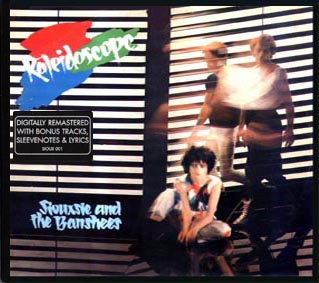
Cat: 983 6913
Click on cover for full scan
Liner notes courtesy of Mark Paytress
Siouxsie & The Banshees
| KALEIDOSCOPE
Includes scans of LPs, cassettes, CDs, promos, imports, limited editions and adverts. Also includes track listings, catalogue numbers, release dates, chart positions, credits, liner notes and reviews. |
|
|
| REMASTERED CD | |||
|
|
|||
| |
|||
| UK CD | Track Listing | ||
|
|
|||
 Cat: 983 6913 Click on cover for full scan |
|
||
| Notes: |
All songs remastered Liner notes courtesy of Mark Paytress
|
||
| Released: | 29/05/06 | ||
| UK Chart: | No. | ||
| US Chart: | No. | ||
| Sleeve Design: | Rob O'Connor | ||
| Re-issue Design: | Julien Potter at Bold, London | ||
| Producer: | Nigel
Gray Siouxsie & The Banshees |
||
| Digitally Remastered By: | Gary Moore | ||
| Tapes Sourced By: | Zoe Roberts/Steven Severin | ||
| LINER NOTES | ||
|
|
||
| It
was the biggest news story since the death of original Banshees drummer
Sid Vicious in February... On 7 September 1979, Siouxsie And The
Banshees guitarist John McKay and drummer Kenny Morris walked out of a
signing session at The Other Record Shop in Aberdeen, collected a few
things from their hotel and took the first train out of Scotland and -
though they didn't know it then - into lifetime obscurity. In an
act of deliberate, bloody-minded self-destruction, the pair had quit a
band they'd helped transform from punk-isnpired opportunists, into
perhaps the most terrifyingly gifted and innovative rock act of the late
'70s.
At the Capital Theatre later that evening, Siouxsie and bassist Steven Severin, the two original and remaining members, performed an impromptu version of 'The Lord's Prayer' backed by members of support band The Cure. And they had a message for the mutinous twosome or "the spineless prima donnas", as Sioux later called them. "I seem to remember telling the audience that if they saw John or Kenny they had my permission and my blessing to kick the shit out of them," she told me in 2003. "Steven and I knew we were going to carry on," she continued. "There was no way that we were going to let John and Kenny ruin what we'd worked for." Since their untrained, barely rehearsed debut at the 100 Club Punk Rock Festival in September 1976, Siouxsie And The Banshees had developed a style that merged the attack and panache of glam rock with the austerity of Berlin-era Bowie and the radical single-mindedness of the early Velvet Underground. McKay and Morris's departure would soon change all that. After completing the autumn '79 tour, with The Cure's Robert Smith and ace drum-for-hire Budgie filling the empty spaces, Sioux and Severin ripped up the template and started all over again. "We were given some time in what was then Chappell Publishing," Severin recalls. "They had a tiny room with a reel-to-reel tape recorder and a little echo box. I'd gone out and bought a drum machine and started playing keyboards and chords on the bass. Siouxsie and I spent a couple of days there writing the basic parts for songs that later ended up on 'Kaleidoscope'. It was a completely different way of doing things and we loved it." Among the songs demoed at Chappell that winter were 'Christine', 'Arabia' (later titled 'Lunar Camel') and 'Paradise Place' (all destined for the album), 'Eve White/Eve Black' (reworked for the B-side of 'Christine') and an electronic piece called 'Sitting Room' which suggested a possible move even further away from rock. "I remember being in a hotel room telling somebody from 'Record Mirror' that we weren't gonna form a band anymore," Severin explains, "that we were going to call upon musicians as and when we needed them. And Siouxsie walks in on the interview and says, I've just asked Budgie to join!" Budgie, a highly rated drummer from the Liverpool new wave scene who'd recently been working with The Slits, seized the opportunity. "I thought they were posh," he said on meeting Sioux and Steven in a bar prior to his audition. "And we thought he was good right from the start." said Sioux. "I tried to forget everything I'd leaned and go in as untutored as I could," Budgie admitted. "It was all about having a blank canvas in front of me musically and seeing where I could go with it. I didn't know any of the songs so I just banged around for half an hour and they seemed to think it was okay. I used Kenny's old drum-kit so it had The Banshees sound to it." Finding a guitarist with the same skills, attitude and flexibility proved more difficult, as some depressing audition sessions during December 1979 confirmed. "But John McGeoch was different," Severin says. "I saw Magazine on television doing 'The Light Pours Out Of Me', and rang up (manager) Nils Stevenson immediately and said, We gotta have him!" "Severin called me and asked if I would be interested in working with the band," McGeoch told me, just months before his death. "I'd finished the third Magazine album, and was doing the Generation X album and some stuff with Steve Strange (Visage), but I said, OK. We met in a pub in Notting Hill, we got on well, and in a couple of days we'd routined 'Happy House'. Though McGeoch was happy to moonlight with The Banshees, touring with them in March 1980 and recording 'Kaleidoscope' in April and May, it was only later in the year that he became a fully-fledged Banshee. "They courted me, and wanted me to commit," he said. "I was sad leaving Magazine, but The Banshees were so interesting. They really believed in what they were doing." Having demoed 'Happy House', 'Hybrid' and 'Desert Kisses' as a four-piece at Polydor, the makeshift band took up McGeoch's advise and called in producer Nigel Gray, fresh from a stint with The Police. 'Kaleidoscope', arguably the most important album of their career, was pieced together over a couple of months in Gray's studio sited, strangely, above a Co-op in Surrey. "We definitely had a concept to the album, which was to make each track completely different," Severin says. "And, for the first time, we did it without thinking about how we would play any of the songs live. It felt like our first opportunity to get stuck into studio works as opposed to recording the live set, and that was a completely new experience for us." The first evidence of the new-style Siouxsie And The Banshees came in March 1980 when 'Happy House' appeared on single. When Siouxsie told 'ZigZag' editor Kris Needs that she'd been feeling "really jolly lately", it was no morale-boosting boast. 'Happy House' was inspired, as light and impish as their previous work had been dark and brooding, while still retaining The Banshees bittersweet trademark. Two months later, at the end of May, came a second single from the sessions. 'Christine', an intimate, acoustic-flavoured song, was inspired by the case of Christine Sizemore and her 22 personalities, continuing a lyric preoccupation with mental breakdown that had been a predominant theme of the band's work from the start. The commercial success of these two 45s backed up Sioux's claim that, "We've got to thank John and Kenny for leaving". In forcing The Banshees to rethink their work, the split had rescued them from a potential cul-de-sac. 'Kaleidoscope' would reveal just how eclectic and open to ideas they were. "We chose that as a title," said Sioux, "because we were discovering we had a lot of sides to ourselves and we were multi-faceted in our approach to making it." 'Kaleidoscope' turned the entire Banshees aesthetic on its head - and even the pacing of the record had altered. Rather than open with a short fanfare piece, followed by a fearsome riff-driven song, as the first two albums had done, both sides of 'Kaleidoscope' hit the ground running, with each side kicking off with a hit single. What happened afterwards, of course, was entirely unpredictable. This was apparent as soon as 'Happy House' gave way to 'Tenant', a bubbling, impressionistic miasma of synths, acoustic guitar, electric sitar and vocal whispers. In comparison with their previous work, this was an almost jazz-like approach. That the piece had been edited down from a 45-minute jam only emphasises the point. 'Trophy' (co-written with McGeoch) and 'Hybrid' marked a return to a full band sound, the latter's discordant guitar intro offering a playful nod to The Banshees of old. In complete contrast were the mantra-like 'Clockface', driven by Sioux's elastic bassline and featuring ex-Sex Pistol Steve Jones on guitar, and 'Lunar Camel', a woozy, richly atmospheric synth-based piece. Much of the rock orientated material was saved for the second side, though whether 'Desert Kisses', the cut that follows the opening 'Christine', could be classed as rock is debatable. Unlike anything else that band had yet written, 'Desert Kisses' is one of The Banshees' best-kept secrets, a vast, filmic set-piece with a gorgeous lullaby melody, string and chorus backing, and a guitar refrain that revisited the Orientalism of the band's 1978 debut single, 'Hong Kong Garden'. "Was that the one that went, 'Cursed and pissed into the ocean'?," McGeoch asked as we sat in his favourite pub beside the Thames. "Well, that was largely Siouxsie's song. It was really subtle, and perhaps a sign of things to come." After the electro-dance minimalism of 'Red Light', a mesmerising indictment of tabloid titillation and an early '80s stage favourite, 'Kaleidoscope' closed with two fearsome blowouts, both employing Steve Jones to good advantage. "He was a surprising choice on the face of it," Severin says, "but you've got to remember that Sioux and I had seen him play dozens of times before anybody else did. We knew he was a great guitarist, and we chose the right songs for him. He came in in one afternoon, just sat there in the control room and hammered his parts out. It was fantastic. And he loved it because it was something people wouldn't expect him to do." With 'Red Light', these last two songs formed a trilogy aimed squarely at the misplaced vanity of a certain kind of woman. 'Paradise Place', carrying perhaps the strongest echo of the old Banshees sound on the entire record, derived its title from a cut-price plastic surgery in Beverly Hills. "One woman went in to have her crow's feet done," smirked Sioux back in 1980, "and one of the surgeons cut her eyelid off. Now she's constantly got one eye open." 'Skin', a final, ferocious assault on fur-wearers, was, said the singer, "a reaction to the feeble excuses for why they kill tigers or anything. It's always, 'There's too many of them, they're eating all the fish.' But if anything is eating too much or taking up too much room, it's people." Years later in 2003, Siouxsie discussed her continued preoccupation with skin in her work. "I suppose it's seeing beyond the mere mortal body," she explained, "and realising that the most important thing in a person is, for want of another word, the spirit." Released in August 1980, 'Kaleidoscope' reached a very gratifying Number 3 in the British charts, the highest placed Siouxsie And The Banshees album yet. "It helped that we set it up so well with two really good singles," says Severin, "though it's hard to believe that it was all done so quickly on the back of the split." And for those who rued the passing of the old Banshees? "People who can't accept changes wouldn't have seen anything in Siouxsie And The Banshees in the first place," he hissed at the time. And, as the remarkable, triumphant sounding 'Israel', the final Banshees release that year, confirms, there were more significant changes afoot, changes that would transform the band into the most powerful touring band - and subcultural phenomenon - of the early 1980s. Mark Paytress 2006. |
||
| IMPORTS/PROMOS | |||
|
|
|||
| |
|||
| Japanese Import CD | Track Listing | ||
|
|
|||
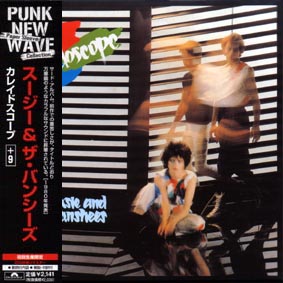 Cat: UICY-93058 Click on cover for full scan |
|
||
| Notes: |
All songs remastered Liner notes courtesy of Simon Goddard Cardboard sleeve is a miniature replica of the original vinyl LP artwork including inner sleeve and lyrics In addition includes pull out poster with lyrics in Japanese
|
||
| Released: | 28/06/06 | ||
| UK Chart: | No. | ||
| US Chart: | No. | ||
| Sleeve Design: | Rob O'Connor | ||
| Re-issue Design: | Julien Potter at Bold, London | ||
| Producer: | Nigel
Gray Siouxsie & The Banshees |
||
| Digitally Remastered By: | Gary Moore | ||
| Tapes Sourced By: | Zoe Roberts/Steven Severin | ||
| PRESS | ||
|
|
||
|
|
||
| Uncut 07/06 | ||
|
|
||
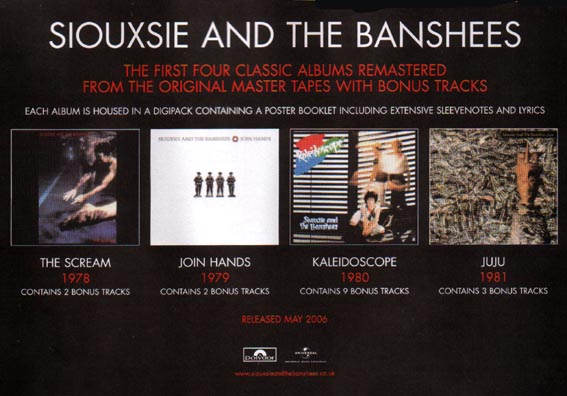 PUNK?
GOTH? GLAM? PSYCHEDELIA? THREE CLASSIC BANSHEES ALBUMS
REMASTERED PUNK?
GOTH? GLAM? PSYCHEDELIA? THREE CLASSIC BANSHEES ALBUMS
REMASTERED
Whether being chatted up by Bill Grundy, or playing alongside Sid Vicious in an early Banshees incarnation at the 100 Club, Siouxsie Sioux is considered central to punk's legend. However the Banshees, formed with glam devotee and fellow disaffected suburbanite Steve Severin, stood counter to the punk ethic. Whereas much punk evoked the bleak, bus-shelter misery of '70s Britain as a stark corrective to prog rock's fantasy universe, the Banshees' confrontation tactics involved scaring up a proto-Goth, anti-romantic world of voodoo, horror and the occult. Scorning the inclusivity of punk ("Everyone can't do it," Severin famously said), the Banshees found immediate popularity. By the time of Join Hands, their second LP in '79, they were no longer the only practitioners of their signature, swirling, sheet-metal guitar sound, as evinced on "Playground Twist". Although "Icon", with its scorched-earth guitar backdrop, captured their very fiery essence, and "The Lord's Prayer" is an exhilarating ordeal, tracks like "Regal Zone" suggest a band scratching at a metal door, uncertain where to go next. The tensions that held the Banshees together dully pulled them apart and, following Join Hands, guitarist John McKay and drummer Kenny Morris acrimoniously quit the band. Kaleidoscope, which bitterly acknowledges the split on "Happy House", is a halfway affair musically, even if new additions Budgie (who adds rhythmic flair to tracks like "Lunar Camel") and ex-Magazine guitarist John McGeoch fit in seamlessly. Most intriguing on this reissue is the addition of demos for, among others, "Christine" and "Paradise Place", real chalk and pins stuff which shows the new line-up struggling to turn a setback into neo-psychedelic opportunity. 1981's Juju, in contrast, was The Banshees' most fully realised album. Alongside the whipcracking dervish of "Spellbound" and the kinetic glitter of "Into The Light", "Halloween" makes a mockery of the clunky Goth scene the Banshees accidentally inspired. And "Voodoo Dolly", which distils the bloodsucking fear the Banshees hoped to inspire, is indicative of a band who, against all odds, were in complete control. Join Hands 4/5 Q&A STEVE SEVERIN UNCUT: Were you 'anti-punk' in some ways? STEVE SEVERIN: Anti the second wave of punk, maybe. People like The Clash, who set up that whole tower block aesthetic. That's not what we were about, nor the Pistols or Wire. I always hated that. How did you approach remaking the band after McKay and Morris split? With a mixture of terror and adrenaline! We were still novices musically. We had to start anew, though that was a blessing - that line-up probably only had one more album in it. You were hailed as the first Goths. How did that feel? We never liked being called punks or Goths. We made videos dressed in white just to distance ourselves from that. Are you friends with McKay and Morris today? Yes, it's all hunky dory. Siouxsie and Budgie met John McKay and his wife-to-be on the eve of their wedding and got them hugely hungover. She said ruining their marriage was revenge for him ruining the band! David Stubbs |
||
| More press... |
||
| CD | |||
|
|
|||
| |
|||
| UK CD | Track Listing | ||
|
|
|||
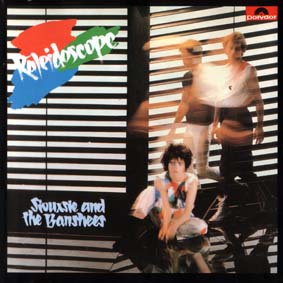 Cat: 839 006-2 Click on cover for full scan |
|||
| First Released On CD: | 10/04/89 | ||
| UK Chart: | N/A | ||
| US Chart: | N/A | ||
| Sleeve Design: | Rob O'Connor | ||
| Producer: | Nigel Gray | ||
| PRESS | ||
|
|
||
| Q 1989 | ||
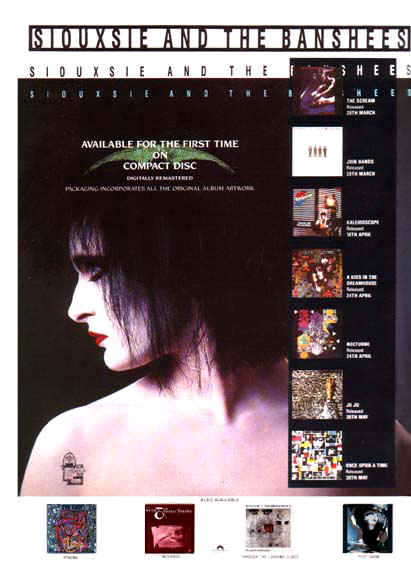 Chilling Chilling
From ice maiden to carnival queen - Siouxsie And The Banshees on CD. At the dawn of punk, Siouxsie Sioux was chiefly renowned for her dismissal of Bill Grundy as "a dirty old man" and for a dress sense designed to provoke an outbreak of British sexual hypocrisy. The Banshees may have made their debut at the 100 Club Punk Festival in 1976 but their extended assault on The Lord's Prayer was as much a dare as a stab at launching a career. Siouxsie's original invention was herself and that unflinching stare remains one of the great icons of punk's disdain. These beginnings render it all the more surprising that, 11 albums on, the Banshees have long transcended the first flush of punk to create an unmatched legacy of dramatic and very British pop. Polydor's release of the first seven Banshees titles on CD means that all their output is now available on compact disc bar the two "holiday projects", The Creatures and The Glove. If Siouxsie's reputation remains that of the haughty Queen of Gothic Punk, these CDs suggest that, within the parameters of their brooding and fantastical world view, there is a good deal more to Siouxsie and her long-term partner Steve Severin than that enduring image suggests. Although Siouxsie and Severin's punk credentials are impeccable, the Banshees were the last of the original punk clan to release a record. By the time Hong Kong Garden entered the Top Ten in August 1978, the Banshees had already seen their fair share of touring and rapidly progressed beyond the confrontational three-chord thrash that had rendered punk a musical cliché. Spearheaded by John McKay's sheet-metal guitar, their debut LP The Scream virtually invented the Gothic rock genre overnight and stands alongside Magazine's Real Life as a turning point in punk's movement away from rabble-rousing and into the internal landscape of the psyche. While songs like Carcass are dated by their goose-stepping beat and stone-faced delivery, the gut-wrenching Overground and the dizzy Jigsaw Feeling demonstrate that already the Banshees were far more concerned with psychodramas of disgust than confronting society head on. The Scream was a new take on suburban angst as Siouxsie's howling vocals intimated that the boredom and alienation of suburban life amounted to nothing less than a horror show. On later albums, the Banshees would uncover a rich exoticism in suburban fears; on The Scream, Steve Lillywhite's thundering production ensures that they sound trapped. Restored on CD to all its forbidding austerity, The Scream is both a declaration of intent and something of an artistic full stop. The following year's Join Hands indicates that while only PiL could match the Banshees' chilling wail of noise, they'd left themselves little room to manoeuvre. McKay's guitar still seesaws disturbingly and Severin's ear for compelling bass riffs is apparent on Placebo Effect, but while Siouxsie turns domestic claustrophobia into Gothic nightmare on Premature Burial and Mother, her vocals are oddly unwieldy. While Hong Kong Garden had displayed an ability to combine a playful sense of unease with driving pop melody, on Join Hands there are only riffs. The departure of McKay and drummer Kenny Morris a mere four days after its release suggests that the Banshees' two halves had indeed reached an impasse. The next album Kaleidoscope featured the now long-serving Budgie on drums and guitar work from John McGeoch and Steve Jones. The Banshees' embattled state obliged Sioux and Severin to rediscover their pop flair and the album's tow singles, Happy House and Christine, display a renewed ability to surround Siouxsie's icy mixture of fatalism and sarcasm in the kind of melodies that even a punk's parents might hum. The inventiveness of a piece like Red Light, driven along by the clicks of a camera shutter, proved that the Banshees were considerably more than a one-trick pony. 1981's Juju finds McGeoch firmly ensconced on guitar, Sioux and Severin devoting themselves to an exhaustive exploration of the power of idols and the Banshees reborn as a magisterial hard rock band. On moody songs like Arabian Knights, Siouxsie unveils a new sensuality while the Banshees display the brooding authority of the Stones circa Paint It Black. Juju confirmed the Banshees' staying power even if their frequent assaults on the singles chart has never own them a mass following like that of The Cure. Most early Banshee albums have their indigestible moments and the argument that they are the best singles band gains some credence from the Once Upon A Time collection where early singles like The Staircase gain contrast from later stabs like the eerie Israel. A sequel is now surely due. A Kiss In The Dreamhouse (1982) found the Banshees further investigating the kind of offbeat textures that Brian Jones brought to the Stones in the mid-'60s. Songs like She's A Carnival and Cascade make gorgeous use of strings while Siouxsie's voice acquires a hidden warmth for studies in erotic extremity like Melt! and Obsession. Dreamhouse probably remains the Banshees' finest hour. In 1983, the Banshees marked time with the live Nocturne, a well-recorded resumé of the band's capacity for Sturm und Drang lightened by the occasional exchange with the audience ("What time tunnel did you crawl out of?" Siouxsie asks one particularly nostalgic punk fan). McGeoch had flown the nest immediately after the Dreamhouse and Nocturne misses his magisterial authority despite Robert Smith's capable but understandably muted understudying. Smith soon departed in turn and the Banshees spent the mid '80s trying to capture their old fire. The Banshee's origins and Siouxsie's forbidding stare have made it hard for them to escape their punk associations while their use of horror imagery has occasionally blinded fans to the questions of power and threatened innocence their unsettling narratives explore. These CDs lend their work a fresh clarity and trace a remarkable evolution which serves as a reminder that, for its bravest exponents, punk was always more a question of daring than a set of conventions. The Scream 4/5 Mark Copper |
||
More press... |
||
| IMPORTS/PROMOS | |||
|
|
|||
| |
|||
| Japanese Import LP | Track Listing | ||
|
|
|||
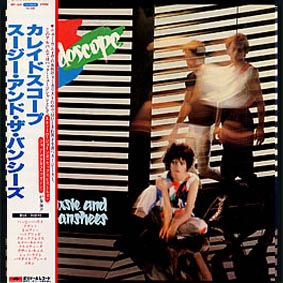
|
|||
|
|
||
| Tenant Lyrics | ||
|
Squatting on
doorsteps So we crawl into
corners But they have eyes
at the keyholes |
||
| Tenant Credits | ||
|
Sioux -
Lyrics |
||
| Inspiration/Influence/Band Comment | ||
| Inspired by the
Roman
Polanski's film of the same name, exploring themes of alienation, isolation and a breakdown
in modern communication.
SEVERIN: "All our influences come from completely different areas. Yet we spend most of our life involved in this world in one way or another, albeit isolated maybe." Source: Option 03/98. |
||
|
|
||
| Christine Lyrics | ||
|
She tries not to
shatter, kaleidoscope style Christine Singing sweet
savages, lost in her world Christine |
||
| Christine Credits | ||
|
Severin -
Lyrics |
||
| Inspiration/Influence/Band Comment | ||
| SIOUXSIE: "It’s about Christine Seisnal (adopts country accent): She’s got twenty two personalities! She don’t know who to play with!"
Source: Zigzag 05/80. STEVE: "All twenty two personalities had different names, which was a really good source for the lyrics - the Strawberry Girl, Banana-split Lady . . .they were either names by her or the family. There’s a book called The Three Faces Of Eve about her, which is more like a biography she wrote with a friend of hers from her childhood, a cousin. She turned out to go to college and become some sort of knob on psychiatry." Source: Zigzag 05/80. SIOUXSIE: "Part of that oppression comes over in our number ‘Christine’. She became a textbook case ‘cause of the traumas she’d been through as a child. She witnessed many violent acts." Source: Sounds 28/02/80. |
||
|
|
||
| Eve White/Eve Black (Demo) | ||
|
Instrumental |
||
|
|
||
| Arabia | ||
|
Instrumental |
||
|
|
||
| Sitting Room | ||
|
Instrumental |
||